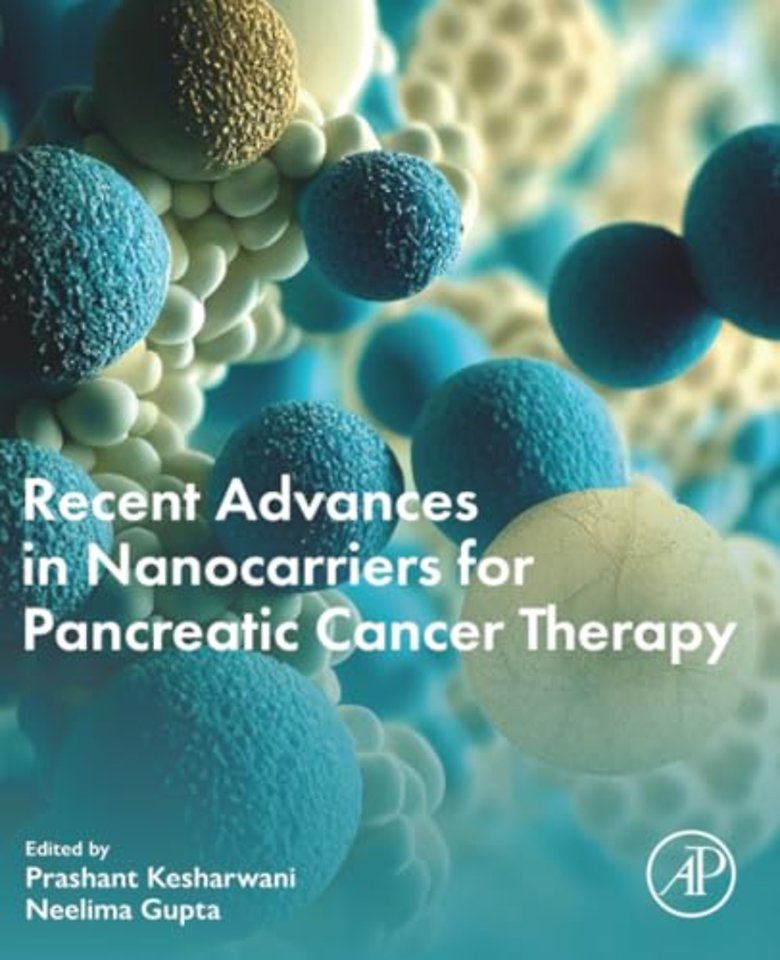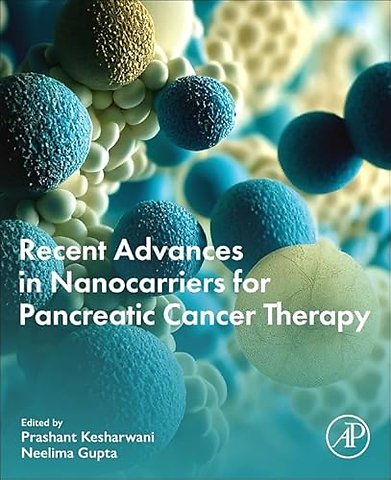<p><br>Part A Overview, molecular pathways and conventional therapy of pancreatic cancer<br><br>1. An overview of the anatomy, physiology, and pathology of pancreatic cancer<br>Farzad Rahmani and Amir Avan<br><br>1.1 Pancreas anatomy <br>1.2 Pancreas physiology<br>1.2.1 Endocrine pancreas<br>1.2.2 Exocrine pancreas<br>1.3 Pancreas cancer pathology <br>1.3.1 Pathology of the exocrine neoplasms of the pancreas <br>1.3.2 Pathology of the endocrine neoplasms of pancreas <br>1.4 Conclusion<br>References<br><br>2. Different combination therapies pertaining to pancreatic cancer <br>Zahra Salmasi, Parisa Saberi-Hasanabadi, Hamidreza Mohammadi and Rezvan Yazdian-Robati<br><br>2.1 Introduction <br>2.2 Carrier-free combination therapy in pancreatic cancer treatment <br>2.3 Nanoparticle-mediated combination therapy in pancreatic cancer treatment <br>2.3.1 Metal and metal oxide nanoparticles <br>2.3.2 Nonmetallic nanoparticles <br>2.3.3 Polymeric nanoparticles <br>2.3.4 Lipid-based nanoparticle <br>2.4 Combination treatment with chimeric antigen receptor T cells and oncolytic viruses <br>2.5 Compounds of natural origin and combination therapy in pancreatic cancer treatment <br>2.5.1 The role of bioactive compounds of natural origin based on nano-formulation in inhibiting the proliferation of pancreatic cancer cells <br>2.6 Conclusions and perspectives <br>References <br><br>Part B Application of various nanocarriers for the management of pancreatic cancer <br><br>3. Potential application of nanotechnology in the treatment and overcoming of pancreatic cancer resistance <br>Shwetapadma Dash, Sonali Sahoo and Sanjeeb Kumar Sahoo<br><br>3.1 Introduction <br>3.2 Current therapeutics for pancreatic cancer <br>3.2.1 Conventional therapies <br>3.2.2 Targeted therapies <br>3.3 Drug resistance as a pitfall <br>3.3.1 Role of drug uptake and drug metabolism pathways <br>3.3.2 Role of key signaling networks <br>3.3.3 Tumor microenvironment <br>3.3.4 Cancer stem cells and epithelial to mesenchymal transition as regulators <br>3.3.5 Other miscellaneous pathways and factors <br>3.4 Nanotechnology as a therapeutic window <br>3.4.1 Nanotherapeutic strategies using chemotherapeutic drugs <br>3.4.2 Nanotherapeutics-based approaches for targeting drug resistance <br>3.4.3 Nanotherapeutics-based approaches for targeting tumor microenvironment <br>3.4.4 Pro- and antiapoptotic genes: evasion and overexpression <br>3.4.5 Nanotherapeutic strategies for targeting cancer stem cells <br>3.4.6 Nanoparticles as delivery vehicles for RNA interference inhibitors <br>3.4.7 Nanomaterials for early detection and advancing pancreatic cancer imaging for pancreatic cancer <br>3.5 Conclusion <br>References <br><br>4. Application of hydrogel-based drug delivery system for pancreatic cancer <br>Naomi Sanjana Sharath, Ranjita Misra and Jyotirmoy Ghosh<br><br>4.1 Introduction <br>4.2 Pancreatic cancer <br>4.3 Physiology <br>4.3.1 Treatment <br>4.4 Limitations <br>4.5 Hydrogels <br>4.6 Types of polymers used in hydrogels <br>4.6.1 Natural polymers <br>4.6.2 Synthetic polymers <br>4.7 Preparation of hydrogels <br>4.7.1 Bulk polymerization <br>4.7.2 Solution polymerization <br>4.7.3 Optical polymerization <br>4.7.4 Enzymatic polymerization <br>4.8 Types of some common hydrogels <br>4.8.1 Injectable hydrogels <br>4.8.2 Temperature-sensitive hydrogels <br>4.8.3 pH-sensitive hydrogels <br>4.8.4 Photosensitive hydrogels <br>4.8.5 Electrosensitive hydrogels <br>4.9 Applications of hydrogels against pancreatic cancer <br>4.10 Diagnosis <br>4.10.1 Therapy <br>4.10.2 Organoid development for cancer treatment <br>4.11 Conclusion and future outlook <br>References <br><br>5. Liposome- and noisome-based drug delivery for pancreatic cancer <br>Rezvan Yazdian-Robati, Seyedeh Melika Ahmadi, Faranak Mavandadnejad, Pedram Ebrahimnejad, Shervin Amirkhanloo and Amin Shad<br><br>Abbreviations <br>5.1 Introduction <br>5.2 Liposome-based drug delivery <br>5.2.1 Components and structure of liposome <br>5.3 Liposomal drug delivery platforms for pancreatic cancer <br>5.3.1 Liposome-drugs to treat pancreatic cancer <br>5.3.2 Liposome—naturally derived bioactive compounds to treat pancreatic cancer <br>5.3.3 Liposomal delivery of CRISPR/Cas9 to treat PC <br>5.4 Targeted nanoliposomes for pancreatic cancer treatment <br>5.4.1 Transporter-targeted liposome for pancreatic cancer therapy <br>5.4.2 Antibody-decorated liposomes for pancreatic cancer <br>5.4.3 Peptide-decorated liposome <br>5.4.4 Carbohydrate-decorated liposomes <br>5.5 Stimuli-responsive liposomal nano-formulations for pancreatic cancer <br>5.5.1 pH-sensitive liposomes <br>5.5.2 Magnetic sensitive and ultrasound liposomes <br>5.5.3 Thermo-sensitive liposomes <br>5.6 Clinical studies of liposomal formulation for pancreatic cancer treatment <br>5.7 Noisome-based drug delivery <br>5.7.1 Structure and components of niosomes <br>5.7.2 Noisome drug delivery for pancreatic cancer treatment <br>5.8 Conclusion <br>Declaration of competing interest <br>References <br><br>6. Micelles-based drug delivery for pancreatic cancer <br>Sanjay Ch, Tarun Kumar Patel, Swati Biswas and Balaram Ghosh<br><br>6.1 Introduction <br>6.2 Micellar uptake mechanism <br>6.2.1 Endocytosis <br>6.2.2 Phagocytosis <br>6.2.3 Pinocytosis <br>6.2.4 Macropinocytosis <br>6.3 Polymeric micelles and their types <br>6.3.1 Conventional polymeric micelles <br>6.3.2 Polymeric micelles based on functionalities <br>6.4 Pancreatic cancertargeting sites for micelles <br>6.4.1 Epidermal growth factor <br>6.4.2 Transferrin <br>6.4.3 Urokinase plasminogen activator receptor <br>6.4.4 Fucosylated antigen <br>6.4.5 Integrins <br>6.5 Small interfering RNA-loaded micelles for pancreatic cancer therapy <br>6.6 Polymeric micelles in clinical studies for pancreatic cancer <br>6.7 Conclusion <br>References <br><br>7. Theranostic nanoparticles in pancreatic cancer <br>Sania Ghobadi Alamdari, Reza Mohammadzadeh, Behzad Baradaran, Mohammad Amini, Ahad Mokhtarzadeh and Fatemeh Oroojalian<br><br>7.1 Introduction <br>7.2 Metal nanoparticles <br>7.2.1 Gold nanoparticles <br>7.2.2 Iron oxide nanoparticles <br>7.2.3 Silica nanoparticles <br>7.2.4 Other metal nanoparticles <br>7.3 Polymeric nanoparticles <br>7.3.1 Natural polymer nanoparticles <br>7.3.2 Synthetic polymer nanoparticles <br>7.4 Carbon nanoparticles <br>7.5 Conclusion <br>References <br><br>8. Recent advances in nanocarriers for pancreatic cancer therapy <br>Shalini Preethi P., Sindhu V., Karthik Sambath, Arun Reddy Ravula, Geetha Palani, Sivakumar Vijayaraghavalu, Shanmuga Sundari I. and Venkatesan Perumal<br><br>8.1 Introduction <br>8.1.1 Cancer <br>8.1.2 Pancreatic cancer <br>8.1.3 Types of pancreatic cancer <br>8.2 Polymeric nanoparticles <br>8.2.1 Passive targeting <br>8.2.2 Active targeting <br>8.2.3 Responsive polymeric nanoparticles <br>8.2.4 pH-responsive polymeric nanoparticles <br>8.2.5 Synthesis of polymeric nanoparticles <br>8.2.6 Characterization of polymeric nanoparticles <br>8.3 Diagnosis <br>8.3.1 Risk factors <br>8.3.2 Detection of protein-based biomarkers in blood <br>8.3.3 Detection of nucleic-based biomarkers in blood <br>8.3.4 Imaging techniques <br>8.3.5 Electrochemical detection <br>8.4 Surgical management <br>8.4.1 Preoperative biliary drainage <br>8.4.2 Anastomotic technique <br>8.4.3 Minimally invasive surgery <br>8.4.4 Vascular resection <br>8.5 Medical management <br>8.5.1 Chemotherapy <br>8.5.2 Immunotherapy <br>8.5.3 Radiotherapy <br>8.5.4 Targeted therapy <br>8.5.5 Antibody-mediated therapy <br>8.5.6 Synergistic therapy <br>8.5.7 Radiodynamic therapy <br>8.6 Conclusion <br>References <br><br>9. Metallic nanoparticles-based drug delivery for pancreatic cancer <br>Sara Natalia Moya Betancourt, Jorge Gustavo Uranga, Viviana Beatriz Daboin, Paula Gabriela Bercoff and Julieta Soledad Riva<br><br>9.1 Introduction <br>9.2 Gold nanoparticles <br>9.3 Silver nanoparticles <br>9.4 Iron oxide nanoparticles <br>9.5 Other metallic nanoparticles (Pd, Pt, CuO, ZnO, TiO2) <br>9.6 Mesoporous silica nanoparticles <br>9.7 Conclusion <br>Acknowledgments <br>Conflicts of interest <br>References <br><br>10. Empowering treatment strategies for pancreatic cancer by employing lipid nanoparticle-driven drug delivery <br>Sumit Sheoran, Swati Arora, Aayushi Velingkar, Smita C. Pawar and Sugunakar Vuree<br><br>10.1 Introduction <br>10.2 Symptoms and risk factors of pancreatic cancer <br>10.2.1 The stages of pancreatic cancer? <br>10.3 Lipid nanoparticles <br>10.4 Solid lipid nanoparticles <br>10.5 Limitations of solid lipid nanoparticles and way to overcome <br>10.6 High pressure-induced drug degradation <br>10.7 Lipid crystallization and drug incorporation <br>10.8 Several colloidal species coexist <br>10.9 Nanostructured carriers of lipid (solid lipid nanoparticles and nanostructured lipid carriers) <br>10.9.1 Solid lipid nanoparticles and nanostructured lipid carriers for drug delivery <br>10.9.2 Solid lipid nanoparticles as delivery carriers for anticancer agents <br>10.9.3 Routes of delivering <br>10.10 Applications of solid lipid nanoparticles in pancreatic cancer <br>10.11 Conclusion <br>References <br><br>11. Solid lipid nanoparticle-based drug delivery for pancreatic cancer <br>Dipanjan Ghosh, Gouranga Dutta, Arindam Chatterjee, Abimanyu Sugumaran, Gopal Chakrabarti and Sivakumar Manickam<br><br>11.1 Introduction <br>11.2 Lipid classifications for solidlipid nanoparticle synthesis <br>11.3 Preparations techniques of solid lipid-based nanoparticles <br>11.3.1 High-pressure homogenization <br>11.3.2 Ultrasonication <br>11.3.3 Coacervation <br>11.3.4 Solvent emulsification evaporation <br>11.3.5 Microemulsions <br>11.4 Role of pancreatic lipase and lipid nanoparticle in pancreatic cancer therapy <br>11.5 Enhancing cancer therapeutic efficacy with lipid-based nanoparticles <br>11.5.1 Gemcitabine <br>11.5.2 Paclitaxel <br>11.5.3 Irinotecan <br>11.5.4 Capecitabine <br>11.5.5 5-fluorouracil <br>11.5.6 RNA-based delivery system <br>11.6 Future aspects <br>References <br><br>12. Dendrimers and carbon nanotubes-based drug delivery for pancreatic cancer <br>Mehmethan Yıldırım, Durmus Burak Demirkaya and Serap Yalcin<br><br>12.1 A brief overview of pancreatic cancer <br>12.2 Drug delivery for cancer therapy <br>12.3 Carbon nanotubes <br>12.4 Dendrimers <br>12.4.1 Poly-L-lysine-based dendrimers <br>12.4.2 Polyamidoamine dendrimers <br>12.4.3 Polypropylene imine dendrimers <br>12.4.4 Frechet-type dendrimers <br>12.4.5 Core-shell tecto dendrimer <br>12.4.6 Chiral dendrimers <br>12.4.7 Liquid crystal dendrimers <br>12.4.8 Peptide dendrimers <br>12.4.9 Polyester dendrimers <br>12.5 Dendrimers and carbon nanotubes-based drug delivery for pancreatic cancer <br>12.6 Conclusion <br>References <br>Further reading <br><br>Part C Recent advances and future prospective for pancreatic cancer <br><br>13. Personalized medicine and new therapeutic approach in the treatment of pancreatic cancer <br>Hanieh Azari, Ghazaleh Khalili-Tanha, Elham Nazari, Mina Maftooh, Seyed Mahdi Hassanian, Gordon A. Ferns, Majid Khazaei and Amir Avan<br><br>13.1 Introduction <br>13.1.1 Pancreatic cancer: common treatment <br>13.2 Could personalized medicine transform healthcare? <br>13.2.1 What is personalized medicine? <br>13.2.2 Precision or personalized medicine: what’s the difference? <br>13.2.3 Advantages of personalized medicine <br>13.3 The role of personalized medicine in pancreatic cancer <br>13.4 Recent progress in personalized medicine for pancreatic cancer therapy <br>13.5 The molecular landscape of pancreatic cancer <br>13.6 Genomic subgroups <br>13.7 Transcriptomic subgroup <br>13.8 Predictive markers of pancreatic cancer for personalized therapy <br>13.9 Examples of precision medicine in pancreatic cancer <br>13.9.1 Patient derived xenograft <br>13.9.2 Patient’s derived organoid <br>13.10 The advantages of microfluidic devices <br>13.11 General scheme of producing a pancreatic organoid <br>13.12 Some applications of pancreatic organoids <br>13.12.1 RNA-based therapeutic tool for personalized PDAC treatment <br>13.12.2 Radiomics and deep learning in personalized medicine <br>13.13 The quantitative imaging methods for pancreatic cancer diagnosis, prognosis, and prediction <br>13.14 Challenges and innovations in personalized medicine care <br>13.15 Challenges in the treatment of pancreatic cancer <br>13.16 The challenges from an oncologist’s perspective <br>13.17 Opportunities for personalized therapy in the near future <br>13.18 Conclusion <br>Declarations of interest <br>References <br><br>14. Clinical practice guidelines for interventional treatment of pancreatic cancer <br>Ghazaleh Pourali, Ghazaleh Donyadideh, Shima Mehrabadi, Mina Maftooh, Seyed Mahdi Hassanian, Gordon A. Ferns, Majid Khazaei and Amir Avan<br><br>14.1 The definition of pancreatic cancer and its classification in clinic <br>14.2 Incidence and epidemiology and risk factors <br>14.2.1 Modifiable risk factors <br>14.2.2 Nonmodifiable risk factors <br>14.3 Surgical treatment of pancreatic cancer <br>14.4 Nonsurgical therapies <br>14.4.1 Chemotherapy <br>14.4.2 Chemoradiotherapy <br>14.4.3 Radiotherapy <br>14.4.4 Ablative techniques <br>14.5 Treatment in metastatic patient <br>14.5.1 First-line chemotherapy <br>14.5.2 Second-line chemotherapy <br>14.5.3 Side effects and future perspective <br>Grant <br>Conflict of interest <br>References <br><br>15. Aptamer-mediated nano-therapy for pancreatic cancer <br>Seyyed Mobin Rahimnia, Sadegh Dehghani, Majid Saeedi, Amin Shad and Rezvan Yazdian-Robati<br><br>15.1 Introduction <br>15.2 Nanotechnology as a novel cancer therapeutic strategy <br>15.3 Aptamers as an advance targeted strategy in cancer diagnosis and treatment <br>15.4 Aptamer design approaches <br>15.5 Methods for coupling aptamers to nanoparticles <br>15.6 Tumor markers for pancreatic cancer <br>15.7 Aptamers against pancreatic cancer <br>15.8 Aptamers in clinical trials for pancreatic cancer <br>15.9 Aptamer-functionalized nanocarriers against pancreatic cancer <br>15.9.1 Aptamer-functionalized calcium phosphosilicate nanoparticles <br>15.9.2 Aptamer-functionalized gold nanoparticles <br>15.9.3 Aptamer-functionalized lipid nanoparticles <br>15.9.4 Aptamer-functionalized magnetic nanoparticles for treatment of pancreatic cancer <br>15.9.5 Aptamer-functionalized polymeric nanoparticles <br>15.9.6 Aptamer-functionalized albumin nanoparticles <br>15.10 Conclusion <br>Conflict of interest <br>References <br><br>16. Photodynamic therapy for pancreatic cancer <br>Rezvan Yazdian-Robati, Atena Mansouri, Peyman Asadi, Mehdi Mogharabi-Manzari and Mohsen Chamanara<br><br>16.1 Pancreatic cancer <br>16.2 Principles of photodynamic therapy <br>16.3 Elements of photodynamic therapy <br>16.3.1 Photosensitizers agents in photodynamic therapy <br>16.3.2 Light (600800 nm) <br>16.3.3 Oxygen <br>16.4 Nanoparticles mediated photodynamic therapy for pancreatic cancer <br>16.5 Combination of photodynamic therapy with other therapies in pancreatic cancer treatment <br>16.5.1 Combination of photodynamic therapy with radiation therapy <br>16.5.2 Combination of photodynamic therapy with immunotherapy <br>16.5.3 Combination of photodynamic therapy with chemotherapy <br>16.5.4 Combination of photodynamic therapy with chemotherapy and immunotherapy <br>16.5.5 Combination of photodynamic therapy with sonodynamic therapy <br>16.5.6 Combination of photodynamic therapy with photothermal therapy <br>16.6 Summary and outlook <br>Declaration of competing interest <br>References <br><br>17. Future prospect of nano-based drug delivery approaches against pancreatic cancer and expected pitfalls of the technology <br>K.R. Manu, Gurleen Kaur, Ananya Kar, Lopamudra Giri, Waleed H. Almalki, Neelima Gupta, Amirhossein Sahebkar, Prashant Kesharwani and Rambabu Dandela<br><br>17.1 Introduction <br>17.2 Conventional therapy for pancreatic cancer <br>17.2.1 Surgery <br>17.2.2 Chemotherapy <br>17.2.3 Radiation therapy <br>17.2.4 Targeted therapy <br>17.3 The prospects of nanotechnology in pancreatic cancer treatment <br>17.4 Applications of various types of nano-based drug delivery systems for pancreatic cancer therapy <br>17.4.1 Hydrogel-based drug delivery systems <br>17.4.2 Nanoemulsion-based drug delivery systems <br>17.4.3 Liposome- and niosome-based drug delivery systems <br>17.4.4 Polymeric nanoparticlebased drug delivery systems <br>17.4.5 Micelle-based drug delivery systems <br>17.4.6 Metallic nanoparticlebased drug delivery systems <br>17.4.7 Solid lipid nanoparticlebased drug delivery systems <br>17.4.8 Quantum dotbased drug delivery systems <br>17.4.9 Dendrimer-based drug delivery systems <br>17.4.10 Carbon nanotubebased drug delivery systems <br>17.5 Challenges of nano-based drug delivery system for pancreatic cancer therapy <br>17.6 Conclusion and future perspective <br>Acknowledgments <br>Reference <br><br>Index </p>

